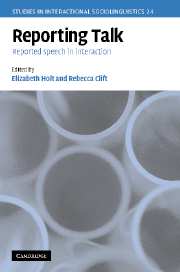Book contents
- Frontmatter
- Contents
- List of contributors
- Acknowledgements
- Transcription conventions
- 1 Introduction
- 2 Interactive Footing
- 3 ‘I'm eyeing your chop up mind’: reporting and enacting
- 4 Assessing and accounting
- 5 Getting there first: non-narrative reported speech in interaction
- 6 Reported thought in complaint stories
- 7 Designing contexts for reporting tactical talk
- 8 Active voicing in court
- 9 Speaking on behalf of the public in broadcast news interviews
- 10 The dead in the service of the living
- References
- Index
6 - Reported thought in complaint stories
Published online by Cambridge University Press: 22 September 2009
- Frontmatter
- Contents
- List of contributors
- Acknowledgements
- Transcription conventions
- 1 Introduction
- 2 Interactive Footing
- 3 ‘I'm eyeing your chop up mind’: reporting and enacting
- 4 Assessing and accounting
- 5 Getting there first: non-narrative reported speech in interaction
- 6 Reported thought in complaint stories
- 7 Designing contexts for reporting tactical talk
- 8 Active voicing in court
- 9 Speaking on behalf of the public in broadcast news interviews
- 10 The dead in the service of the living
- References
- Index
Summary
Introduction
Research has been conducted on interactional reported speech, i.e. presentations of what interactants have said in an interaction (see e.g. Holt, 1996, 2000; Tannen, 1989; and other chapters in this volume), but the use of reported thought has attracted much less attention in interactional studies, and in studies of reported speech in general. In this chapter, I focus on the construction and design and use of reported thoughts – especially on I thought that-constructions – in one specific activity environment, complaint stories about the actions of other people. Previous research has already shown that there are some interactional environments in which speakers frequently make use of reported speech, especially of direct reported speech: story-telling seems to be the major (but not the only) environment for reported speech (see, for example, Labov, 1972; Holt, 1996, 2000), and there might be some types of stories that especially favour the use of (direct) reported speech. Holt (2000) analyses two such story types, complaints and amusing stories. In analysing a database of Finnish complaint stories, I found that reported thought is also a recurrent device in complaint stories, and one of the devices that is used to construct complaint stories as complaint stories. This chapter demonstrates that reported thought is a well-fitted device for constructing complaints.
The chapter also argues that reported thought deserves attention on its own – most often it has just been seen as part of reported speech, but its specific functions in interaction have not been analysed.
- Type
- Chapter
- Information
- Reporting TalkReported Speech in Interaction, pp. 150 - 178Publisher: Cambridge University PressPrint publication year: 2006
- 10
- Cited by



